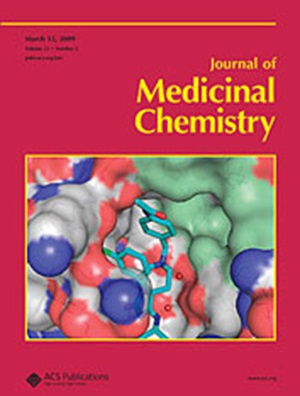AI-Driven De Novo Design and Development of Nontoxic DYRK1A Inhibitors
IF 6.8
1区 医学
Q1 CHEMISTRY, MEDICINAL
引用次数: 0
Abstract
Dual-specificity tyrosine-phosphorylation-regulated kinase 1A (DYRK1A) is implicated in several human diseases, including DYRK1A syndrome, cancer, and neurodegenerative disorders such as Alzheimer’s disease, making it a relevant therapeutic target. In this study, we combine artificial intelligence with traditional drug discovery methods to design nontoxic DYRK1A inhibitors. An ensemble QSAR model was used to predict binding affinities, while a directed message passing neural network evaluated toxicity. Novel compounds were generated using a hierarchical graph-based generative model and subsequently refined through molecular docking, chemical synthesis, and experimental validation. This pipeline led to the identification of pyrazolyl-1H-pyrrolo[2,3-b]pyridine 1 as a potent inhibitor, from which a new derivative series was developed. Enzymatic assays confirmed nanomolar DYRK1A inhibition, and additional assays demonstrated antioxidant and anti-inflammatory properties. Overall, the resulting compounds exhibit strong DYRK1A inhibition and favorable pharmacological profiles.

ai驱动的无毒DYRK1A抑制剂的从头设计和开发
双特异性酪氨酸磷酸化调节激酶1A (DYRK1A)与多种人类疾病有关,包括DYRK1A综合征、癌症和神经退行性疾病如阿尔茨海默病,使其成为相关的治疗靶点。在这项研究中,我们将人工智能与传统的药物发现方法相结合,设计无毒的DYRK1A抑制剂。使用集合QSAR模型预测结合亲和力,而定向信息传递神经网络评估毒性。使用基于分层图的生成模型生成新化合物,随后通过分子对接,化学合成和实验验证进行改进。这条管道导致吡唑基- 1h -吡咯[2,3-b]吡啶1被鉴定为有效的抑制剂,并由此开发了一个新的衍生物系列。酶分析证实了纳米摩尔DYRK1A的抑制作用,另外的分析显示了抗氧化和抗炎的特性。总的来说,所得到的化合物表现出强烈的DYRK1A抑制作用和良好的药理学特征。
本文章由计算机程序翻译,如有差异,请以英文原文为准。
求助全文
约1分钟内获得全文
求助全文
来源期刊

Journal of Medicinal Chemistry
医学-医药化学
CiteScore
4.00
自引率
11.00%
发文量
804
审稿时长
1.9 months
期刊介绍:
The Journal of Medicinal Chemistry is a prestigious biweekly peer-reviewed publication that focuses on the multifaceted field of medicinal chemistry. Since its inception in 1959 as the Journal of Medicinal and Pharmaceutical Chemistry, it has evolved to become a cornerstone in the dissemination of research findings related to the design, synthesis, and development of therapeutic agents.
The Journal of Medicinal Chemistry is recognized for its significant impact in the scientific community, as evidenced by its 2022 impact factor of 7.3. This metric reflects the journal's influence and the importance of its content in shaping the future of drug discovery and development. The journal serves as a vital resource for chemists, pharmacologists, and other researchers interested in the molecular mechanisms of drug action and the optimization of therapeutic compounds.
 求助内容:
求助内容: 应助结果提醒方式:
应助结果提醒方式:


